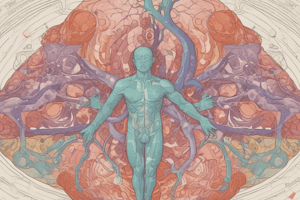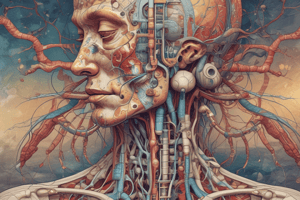Podcast
Questions and Answers
What is an example of autocrine signaling?
What is an example of autocrine signaling?
- Hormone production in response to T lymphocyte activity
- Hormone production in response to endocrine signaling
- Hormone production in response to paracrine signaling
- Immune response with the production of T lymphocytes (correct)
How many major hormones are produced by the human body?
How many major hormones are produced by the human body?
- 15
- 20 (correct)
- 25
- 30
What is required for a hormone to elicit a response within a cell?
What is required for a hormone to elicit a response within a cell?
- Presence of a different hormone
- Presence of a specific receptor (correct)
- Presence of regulatory G proteins
- Absence of a specific receptor
How do steroid hormones alter target cell activity?
How do steroid hormones alter target cell activity?
What are the three factors that affect target cell activation?
What are the three factors that affect target cell activation?
What determines the magnitude of the response to a hormone?
What determines the magnitude of the response to a hormone?
What is a characteristic of hormones in the body?
What is a characteristic of hormones in the body?
Which gland is responsible for making the decision of which hormones are released in the body?
Which gland is responsible for making the decision of which hormones are released in the body?
What is the primary function of the thymus?
What is the primary function of the thymus?
What type of hormone is cortisol?
What type of hormone is cortisol?
What is the primary mechanism of hormone action involved in growth and development?
What is the primary mechanism of hormone action involved in growth and development?
What is a result of hormone action on target cells?
What is a result of hormone action on target cells?
Flashcards are hidden until you start studying
Study Notes
Hormone Signaling Overview
- Estrogen exhibits autocrine signaling, impacting its own production during immune responses, such as T lymphocyte generation.
- Hormones engage in communication between cells across different parts of the body, influencing multiple target cells.
- The human body produces approximately 20 major hormones, each capable of eliciting varied responses based on receptors on different cells.
Hormonal Action Mechanisms
- Hormones modify target cell activities through two primary mechanisms:
- Second messenger systems, often involving regulatory G proteins.
- Direct gene activation, notably with steroid hormones.
- Target cell responses hinge on:
- The hormone concentration in circulation.
- The number of available receptors on target cells.
- The binding affinity of the hormone to its receptor.
Characteristics of Hormones
- Hormones are generally slow-acting and are integral to processes including sexual functions, mood regulation, cellular growth, and metabolism.
- Both endocrine and nervous systems interact, coordinating physiological responses within target cells.
- Hormonal effects typically display a lag period before manifesting, ensuring smooth systemic regulation.
Major Hormonal Functions
- Hormones regulate several critical functions:
- Reproductive processes
- Growth and development
- Immune defense mechanisms
- Homeostatic balance
- Metabolic regulation
- Hormonal effects can last from minutes to several days, coordinating vital activities based on specific receptor interactions.
Key Endocrine Glands and Their Hormones
- Pineal Gland: Releases melatonin, regulating the sleep-wake cycle.
- Hypothalamus: Key player in hormone regulation, controlling the endocrine system; size of an almond.
- Thyroid Gland: Regulates metabolism, growth, and development through hormone secretion.
- Thymus: Produces white blood cells, essential for immune defense.
- Adrenal Glands: Secrete various hormones including adrenaline.
- Pancreas: Critical for digestion and blood glucose control.
- Ovaries and Testes: Produce sex hormones essential for reproductive functions.
Hormonal Effects on Cellular Activity
- Hormones can alter:
- Plasma membrane permeability and electrical state.
- Protein synthesis and regulatory molecule production (anabolic processes).
- Enzyme activation and inactivation.
- Mitosis, fostering cellular growth and development.
- Secretory activities, influencing the release or repression of additional hormones.
Chemical Classifications of Hormones
- Amino Acid-Based Hormones:
- Include peptide and protein hormones; examples are insulin and glucagon.
- Amino acids contribute to amine hormones like epinephrine (adrenaline).
- Steroid Hormones:
- Lipid-based hormones related to gonadal and adrenocortical functions; e.g., cortisol.
- Eicosanoids:
- Include leukotrienes and prostaglandins; biologically active lipids that mimic hormone functions.
Types of Hormonal Signaling
- Endocrine Signaling: Typical mechanism for growth and development hormones, affecting distant target cells.
- Paracrine Signaling: Operates on neighboring cells, influencing immediate local responses.
Studying That Suits You
Use AI to generate personalized quizzes and flashcards to suit your learning preferences.




